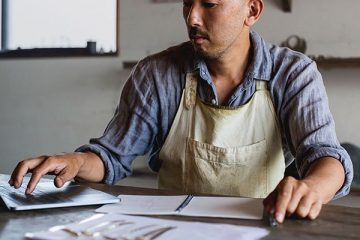Digitally mapping for solidarity and cooperation

Activists are using digital mapping technology to help build connections between grassroots organisers, local community groups and worker-owned enterprises in an attempt to foster greater collaboration between them.
The idea is to help increase the visibility of alternative economic, social and political institutions or initiatives outside of the mainstream capitalist paradigm, and to help these entities build connections with one another to more effectively organise and take action together.
The work being undertaken by the volunteer-led Covid-19 Mutual Aid UK, which was set up to support local community groups organising mutual aid during the coronavirus pandemic, is an example of such an initiative at work, which uses the mapping technology to connect individuals with their local mutual aid groups and expand the network of people autonomously self-organising in the UK.
According to Julian Tapales, who sits on the organisation’s tech working group, the map was needed to help people find and connect with local mutual aid efforts because of how rapidly new groups were springing up. All of the new mutual aid initiatives were initially being added to Google Sheets, but as the groups got larger and began to fragment into even more localised units, it became increasingly challenging for people to navigate them and find the groups they were looking for.
This led to the group using the information to populate a digital map instead, which was synced manually at first but is now a fully automated process, with a database set up to automatically aggregate the information from external sources such as Sheets.
As of publication 4,243 mutual aid initiatives have been mapped in the UK alone. “We’re not interested in being a top-down form of organisation, and as such we’re trying as much as possible to just connect people and enable local mutual aid,” says Tapales, who characterised the initiative as a “platform of documentation”.
“Each community knows best for itself. Our role in this is to enable people to connect with their local communities, and we eventually hope that these mutual aid groups can connect with each other and share experiences and approaches they’ve had. I think that was always at the forefront of everyone’s minds, it’s just that the technical infrastructure wasn’t set up for that.”
One single source of truth
Tapales adds that it was important to have one single source of truth – the Mutual Aid Wiki project where the map is embedded – for information about mutual aid groups, and that the next steps were linking and syncing new data from other sources, including mapping initiatives in other countries, to “open up potential for more cross-collaboration” internationally.
“One of our main plans is to develop this community of people involved in their countries mutual aid organising, so we can develop this resource for everyone’s benefit,” he says, adding the project is entirely open source with code already freely available online for developers that want to help build the map.
“London groups and groups in other major cities can connect, for example, because the challenges that groups in cities encounter are quite different from the challenges in more rural areas.”
As such, the map now contains information about mutual aid initiatives in Germany, Spain, India, Kenya, Nigeria, Canada and the US among others.
Mapping the solidarity economy
Another group engaged in mapping alternative institutions is the Solidarity Economy Association (SEA), a not-for-profit, multi-stakeholder co-operative working to support the growth of the Solidarity Economy Initiatives (SEI) in the UK.
According to Colm Massey, a worker member of SEA, the solidarity economy is a social movement originating in Latin America, which has since taken root in some European and North American countries, that seeks to establish a network of alternative economic structures.
“Essentially it’s a loose alliance of networks and organisations trying to build an alternative economy that’s based on … democratic, ecological and participatory [values],” he says.
“The key is trying to bring disparate networks together. You often find people doing brilliant work maybe just in housing, but they don’t talk to people who have very similar values but are working in food security, say – the solidarity economy is a framework for building alliances of networks that have similar values but are actually working in different sectors.”
To help facilitate these connections, SEA ran a pilot mapping programme in Oxfordshire between October 2018 and June 2019 which, according to a report on the project, aimed to make SEI’s “more visible, and therefore able to be supported by more people, and to empower collaboration between SEIs across sectors, resulting in a deeper collective transformation of our communities and economy.
“While there is a lot of grassroots economic activity happening all over the UK that embodies the values of the solidarity economy (SE), the extent to which people are aware of them, or they are aware of each other, is limited.”
Automation
Massey says SEA wanted to therefore create something that could be used by other organisations and networks “without as much hand-holding” and with as few manual steps as possible, leading the team to heavily automate the back-end processes.
To distribute the control over and benefits of the map, SEA also used Linked Open Data to develop the infrastructure, as it decentralises the management and publishing of the data, while also ensuring data published by different parties is interoperable.
This did create issues with licensing, Massey concedes, as having a completely open license means other organisations who have not put much into the movement or who are in fact antagonistic to it can extract a lot of value from people’s volunteer labour.
“What is interesting is actually looking more at peer-to-peer licenses, where you identify the community you want to have free use of everything but put some hurdles and some costs on organisations that fall outside that,” he says. “In many cases its very hard police and do, but with the co-operative movement it’s easier, because you could say ‘if you’re a co-op, you can just use it unlimited for free’, so it’s nice we have a mechanism for identifying certainly part of the community.”
While the data is therefore currently published under an open license, SEA will be exploring how these peer-to-peer alternatives could work going forward.
Massey adds being able to publish connections between different types of organisations, not just co-ops, will be “very powerful” because “it is the nature and quality of the relationships between co-operatives and the wider community that makes solidarity possible”.
As an example, Massey speaks of presenting the data on co-operatives alongside data on mutual aid groups, “so when you go to search for a mutual aid group you’d see there’s 10 co-ops within a stone’s throw and vice versa, co-ops can know where the mutual aid groups are too”.
Mapping the Northeast
A similar project has also taken place in the Northeast of England by the NewBridge Project, an artist-led gallery space which began looking at their programming more politically about five years ago, leading to conversations with SEA.
With knowledge of what SEA was doing in Oxfordshire, the NewBridge Project decided it would be helpful to collaborate with them on building a separate map for the Northeast, prompting programme director Niomi Fairweather to meet with as many co-operatives and SEI’s face-to-face as possible.
This culminated in a meeting of over 180 solidarity economy organisations from the region in October 2018, where the direction of the map was collectively decided upon.
“The map is probably the hardest thing to grasp for us as an organisation because we’re not techie at all, and we’re very small, there’s five of us who work for the organisation and only two full time,” says Fairweather.
“At first we put pressure on ourselves to populate the map and make it look jazzy and interesting, but we realised the most rewarding stuff coming from the map was the conversations, the relationships that we were forging with local organisations we never knew existed.”
The map has ended up on the back burner for now due a lack of funds, she says, but the connections forged through it have lasted, with organisations on the map regularly participating in virtual ‘solidarity socials’ during the pandemic.
NewBridge is still working with SEA on the technical side to make the map more self-manageable, and Fairweather said the organisation hopes the Northeast network will “reach out to other communities across the globe” in much the same way Covid-19 Mutual Aid UK has.
Mapping Dual Power
Across the Atlantic, the Black Socialists in America (BSA) set up an Open Tech Development team to create their Dual Power Map.
According to Z, one of BSA’s founders and its current national coordinator, who has adopted the name to protect their identity, dual power refers to “building a new world in the shell of the old that can challenge the socioeconomic status quo and, ultimately, render it obsolete”.
The aim of the project is to plot every worker cooperative, Small Business Development Center, Community Land Trust, and Dual Power Project within the United States, so that people can connect with or support the ones in their area.
Since the start of the Covid-19 pandemic, BSA is also using the map to plot where strikes and Covid-related mutual aid efforts have happened, so that people can tap into a wider network of support and coordinate further actions together, in line with what Massey said about the power of showing more connections.
As a small organisation with limited resources and capacity, BSA has been using open, publicly available data collected and aggregated by a range of journalists and grassroots groups to feed into the backend of the Dual Power Map.
So far, it has mapped over 100 strikes, 462 worker self-directed enterprises, 367 community land trusts and 878 small business development centres across the US.
“We can’t organise against Capitalism using the tools of the capitalist class. We need digital tools because we’re living in a digital age, and as long as this is the case, the Left needs to step up to build out on alternative digital platforms and tools that are rooted in principles of cooperation and democracy, and that are conducive to what we’d call autonomous ‘dual power’ building,” they say.
“Any workers interested in taking action need to make sure that they’re not acting in isolation. We all need each other in order for striking efforts or any efforts that are about challenging the ruling class to be effective, and to ensure that folks aren’t left hanging out to dry. This means we not only need workers coordinating across different sectors for actual actions, but defensive measures, which includes strike funds, and certain backing from within the unions.”
BSA are currently looking to expand the number of tools available to organisers through the Dual Power App, which Z says will likely have the Dual Power Map functionality as a native application, “meaning it will allow people to look up ‘solidarity economy’ institutions and Left efforts throughout the country”.
Its primary function, though, will be as an organising tool for those looking to build dual power institutions.
“That means it’ll provide safer internal communications networks, project management software, internal voting mechanisms or applications, channels for access to resources and specialists in a wide array of areas, and options in terms of organisation structure or permissions,” says Z.
“Solidarity Economy mapping has been a thing for some years now, but it’s not enough. We have to streamline the democratic-institution-building process for poor and working-class people and their communities in order to build real counter-power and transform our economies and societies. This means we need to do things in an explicitly political fashion.”
Grass-roots security concerns
Both Z and Massey, however, pointed out there are some dangers involved with this kind of mapping that need to be carefully considered too.
For SEA, a big part of its work is building links between solidarity economy groups in different parts of the world, and it has been particularly active in building relationships between co-ops in Europe and Rojava, the predominately Kurdish area of Northern Syria.
“There’s been a huge blossoming of cooperatives there since the civil war and the uprisings, so we did a map of the co-ops we’ve identified,” says Massey, adding SEA was anxious about publishing the map because of the dangers it presented to people on the ground in a conflict zone.
“We talked with the co-op development agencies in Northern Syria that we work with and they wanted it to be mapped, but what we decided was that we would have to obfuscate the location. Basically we published the co-ops at the centre of the nearest town so they couldn’t be a target for a Turkish or ISIS bomb.”
While there are risks in having information about initiatives publicly available, especially in the American context where historically black-led political movements have been met with high levels of state surveillance and repression, Z says openness is vital to promoting the kind of change BSA and others want to see.
“It really depends on what kind of organising you’re doing. Everything BSA and our partners are doing is above-ground, and the program of our organisation and our partners is an above-ground program. This doesn’t mean that the state won’t target us (this is already happening). But it does mean that we can be open,” says Z, adding everything plotted on the Dual Power Map is already out in the open.
“Now because we can be open, this means that we don’t have to struggle in isolation – where local formations and efforts can be backed into a corner much more easily – but can instead be connected to an international network of support while struggling with other forces out in the open.”
For any collaboration, feel free to email us at support@ichibanelectronic.com. Thanks
Source link






















